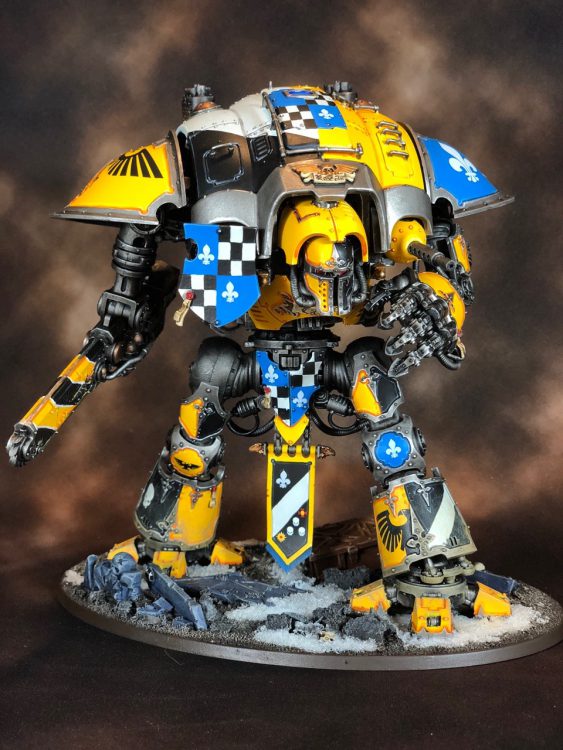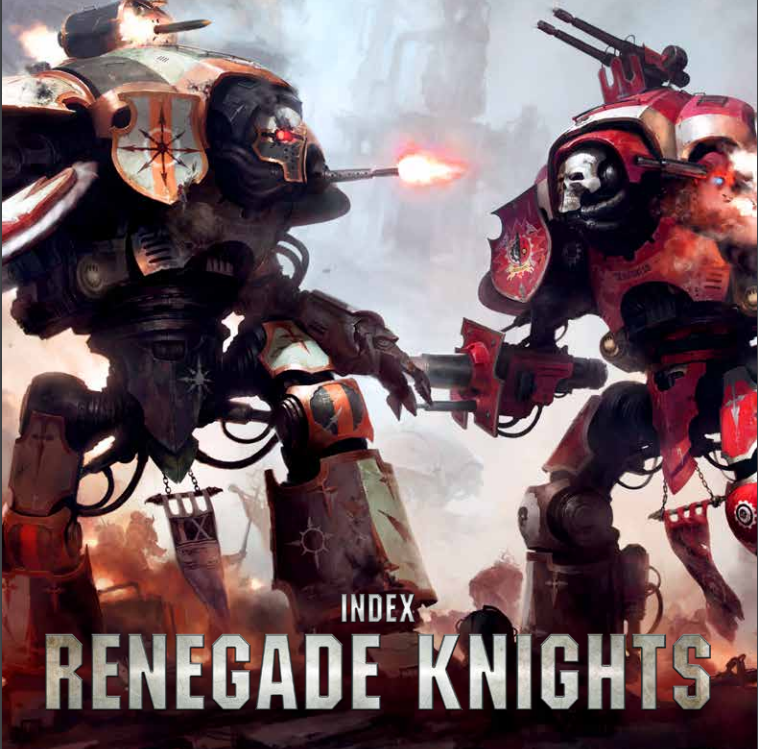In A History of Miniature Violence, we look at the history of wargames, examining different factions, games, and concepts over the years. Today we’re looking at the history of Knights in Warhammer 40,000, colossal war machines piloted by members of noble houses.
Knights – the towering war machines of the 41st millennium – have had three distinct phases over their lifetime – showing up first in Horus Heresy (Epic 1st edition), then in Titan Legions (the 1994 supplement for Epic 2nd edition) and most recently in Warhammer 40,000 proper and with support from Forge World (with the Knight codex in 6th edition 40k published in 2014, and the first Forge World Knight in June 2014). In the next few weeks we’ll see the release of new codexes for both Imperial Knights and their fallen counterparts, Chaos Knights.
Let’s take a look at their history and how we got to this point.
The Beginning
Knights were introduced in June 1990, in White Dwarf 126, and they were introduced for humans and Eldar at the same time. WD126 was published before much of the lore for Warhammer 40,000 had been written – remember, this is still three years before the release of 2nd edition – and this meant that the factions were a lot looser at the time. As a result, human knights might turn up alongside marines, the Imperial Army, or as their own faction.

Reading WD126 there’s a lot of bits of lore that continue to the present day, with the Throne Mechanicum, Mega Fauna on Knight Worlds, etc. Also introduced at this time were the ideas that the Knight worlds moved towards a feudal system and the idea of knight houses, the Sacristans as a secretive tech brotherhood, and the ranks of knights.
Eldar Knights
The core conflict in the background in WD126 centers around the Knight Worlds, which are maiden worlds settled by Eldar Exodites before the Dark Age of Technology (this Exodite exodus preceded the Fall of the Eldar and the launch of the Craftworlds by thousands of years). The Exodites settled on these maiden worlds and converted the vehicles they brought with them to tall and slender knight suits, which a warrior elite used to help terraform the planet. This warrior elite built keeps and developed a chivalric honour code, and called themselves the Eldar Knights. The Knights settled disputes between clans in ritual combat somewhat like jousts.
After the Fall, the craftworlds Eldar offered their Exodite kin a place on the craftworlds, but the Knights knights declined, though they offered to trade food with the with the craftworlds in order to help feed those populations. The Eldar Knights seeded the oceans on their worlds with giant algae beds that were fed on by brontosaurus type creatures, which the Eldar then herded for their meat.
Seems like a pretty sweet deal, doesn’t it? You ride around in your big cool knight suit, herd some brontos and knock off at the end of the day for beers and Eldar BBQ. What could go wrong?
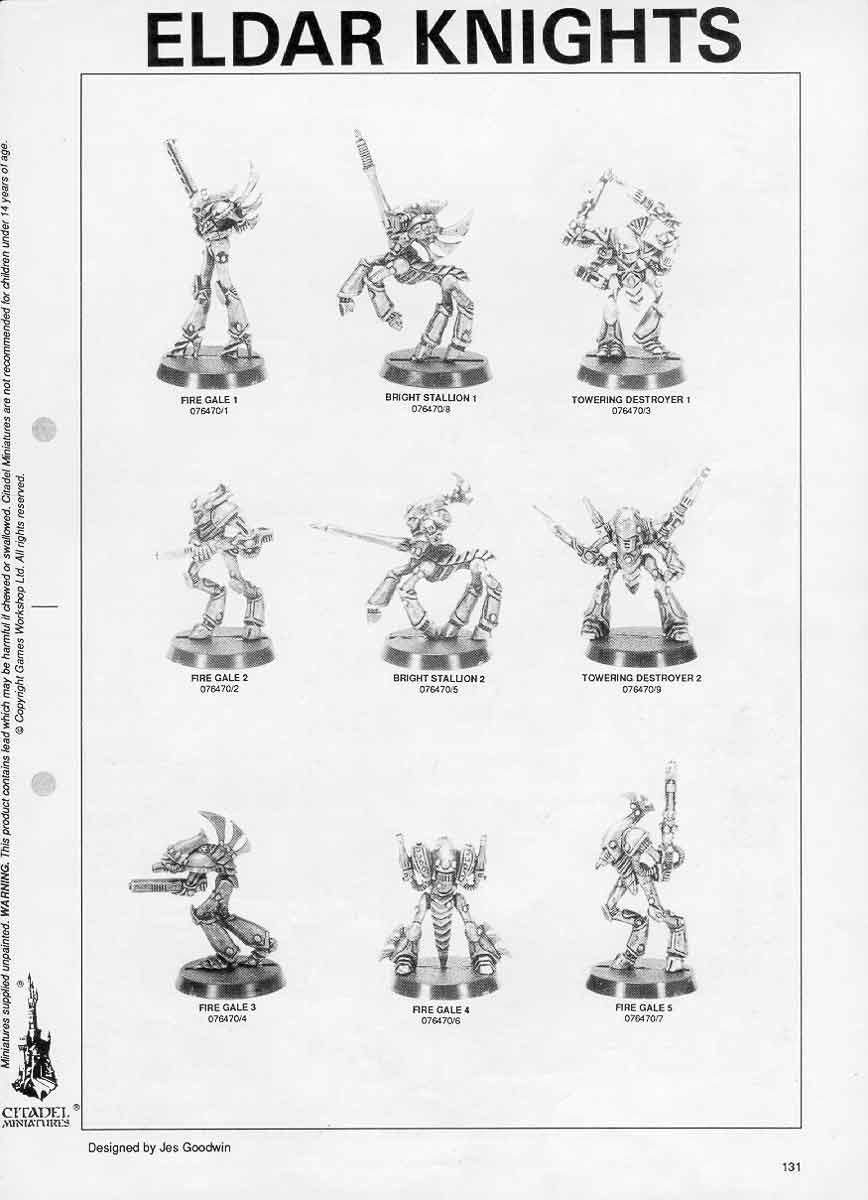
The Coming of Men
During the Dark Age of Technology, scouts from the Human Empire travelled around the galaxy looking for worlds to use to feed humanity. They found the Eldar Knights, and decided to copy and/or steal their thing. This led to human Knights, and a serf class who used Drovers, which were Sentinels with no weapons, to herd the mega fauna.
We see the familiar plot points from the latest knight books (though ditching the concept of human knights as landing on Eldar maiden worlds and copying the Eldar Knights), with these planets evolving a ruling warrior caste based around the ability to use the Throne Mechanicum, a tech priest class in Sacristans, and knightly ranks.
Both Human and Eldar Knights came in three classes:
- Human Lancers and Eldar Bright Stallion knights, which were faster than standard knights
- Human Paladins and Eldar Fire Gales, which were the intermediate rank and file knights
- Human Warden and Eldar Towering Destroyer class knights, which were the heavy support knights
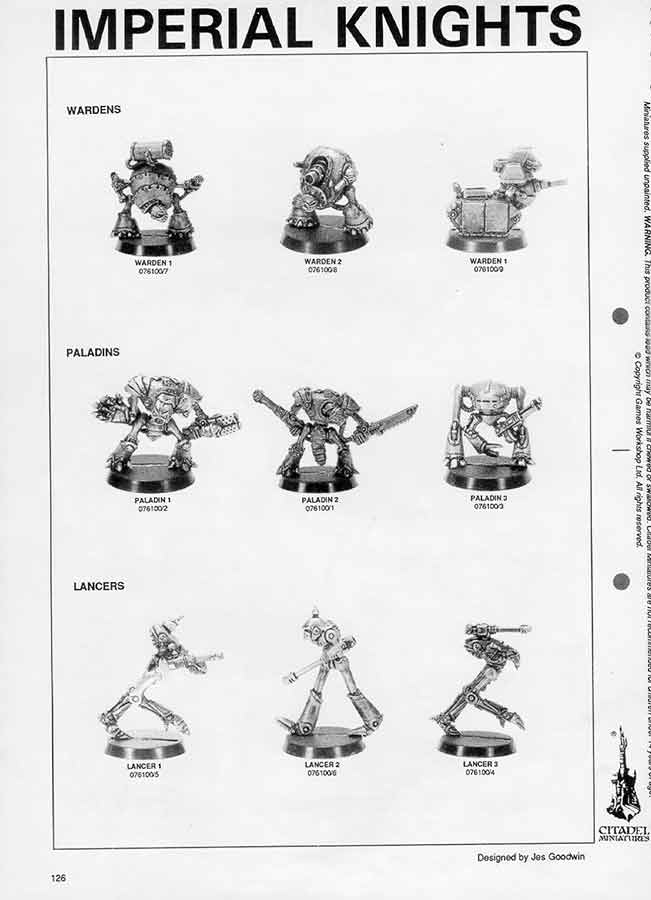
It’s important to mention Jes Goodwin here, as his concept art, sculpting, and design direction run like a thread through the history of Knights, and the quality of the miniatures is a testament to his talent. Jes is a great bloke if you run into him, and happy to have a good old chat about minis.
The Titan Legions
The Human knights were reimagined into Paladins, Errants, Crusaders, Lancers and Castellans in the 1994 Titan Legions supplement for Space Marine (Epic’s 2nd edition). This era had much more hunched-over knight designs reminiscent of the Mars Pattern Warlord Titans of Titan Legions, with the blocky sculpting of the epic models of the era (the Warlord Titan of the Epic 40,000 era exemplified this).
Knight households were given formations, with households based around Paladins as other knight types taken as supporting formations.
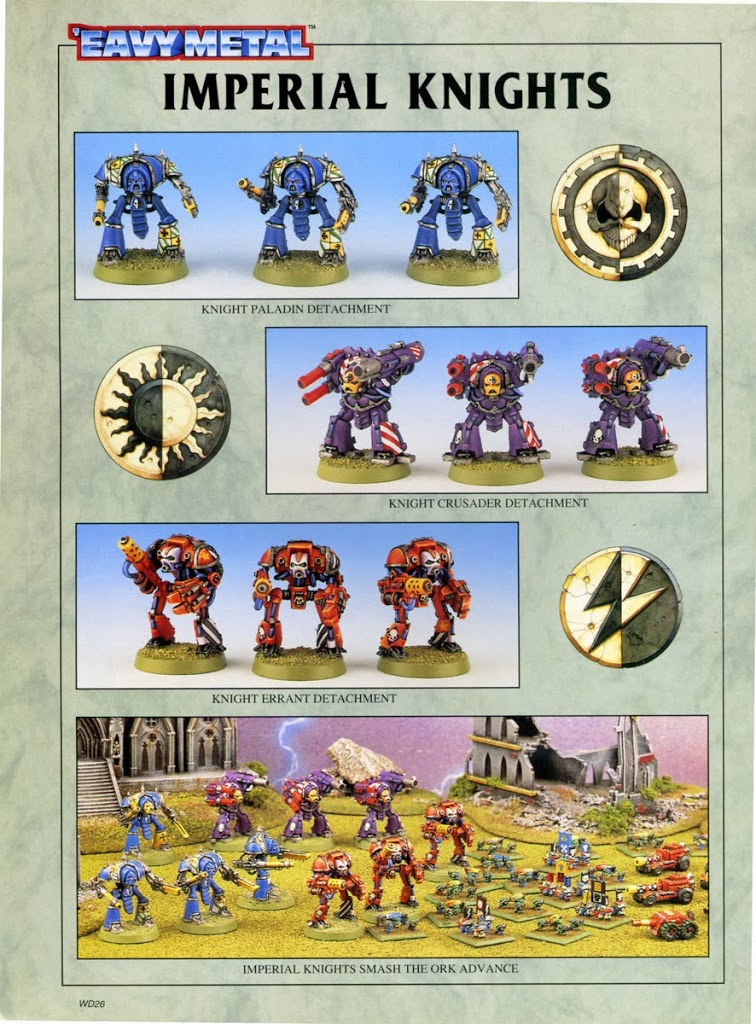
During this period we’d see more distinct battlefield roles emerge for Knights, with paladins armed with a battlecannon and knight-sized chainsword becoming a generalist knight unit that could take on any foe, while Errants were more of a close range anti-armour unit, Lancers were close assault shock troops, while the Crusader and Castellan knights were heavy support knights. There was a specific Baron knight which was a HQ unit, though it was basically a blinged-up Lancer.
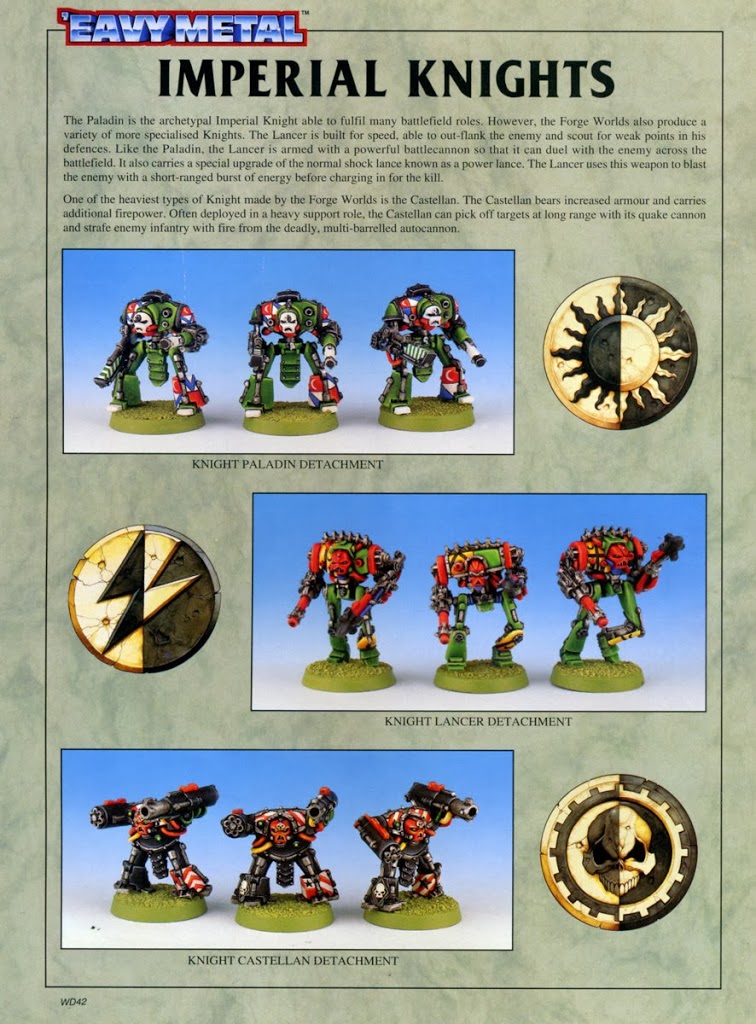

During this time knights were pushed as the accompaniment to Titan Legions, which were available in heavily discounted formations (so you would get three Warlords for 1500 points) and it heavily disadvantaged factions that couldn’t take big units of titans (like Squats).
In this iteration knight types evolved, and we saw Paladins split into Paladins and Errants, while Wardens were split into Crusaders and Castellans. There was a much more uniform look to each knight class, leaving behind the charming hodge-podge look of the original Jes Goodwin miniature range.
Knights arrive in 40k
In the Rogue Trader days vehicles in 40k were a rarity. You had Rhinos, Predators, and Land Raiders for the Imperium, plus the Ork Battlewagon and some lighter vehicles like bikes, jetbikes, trakks, and buggies, as well as a few dreadnoughts, but the larger vehicles from Epic were entirely absent (the Land Raider was as big as vehicles got). This meant that until the late 90s marine players had a full selection of vehicles to play with, but factions like Eldar were very limited in what they had.
Enter Mike Biasi, who upscaled a number of Epic vehicles, starting with the Reaver and Warhound Titans. Mike formed Mike Biasi Studios, and obtained a licence from Games Workshop to produce resin versions of Epic vehicles in 40k scale, with rules being published for them in the fanzine Inquisitor. This meant that the early 90s saw the first 40k Knight miniature.
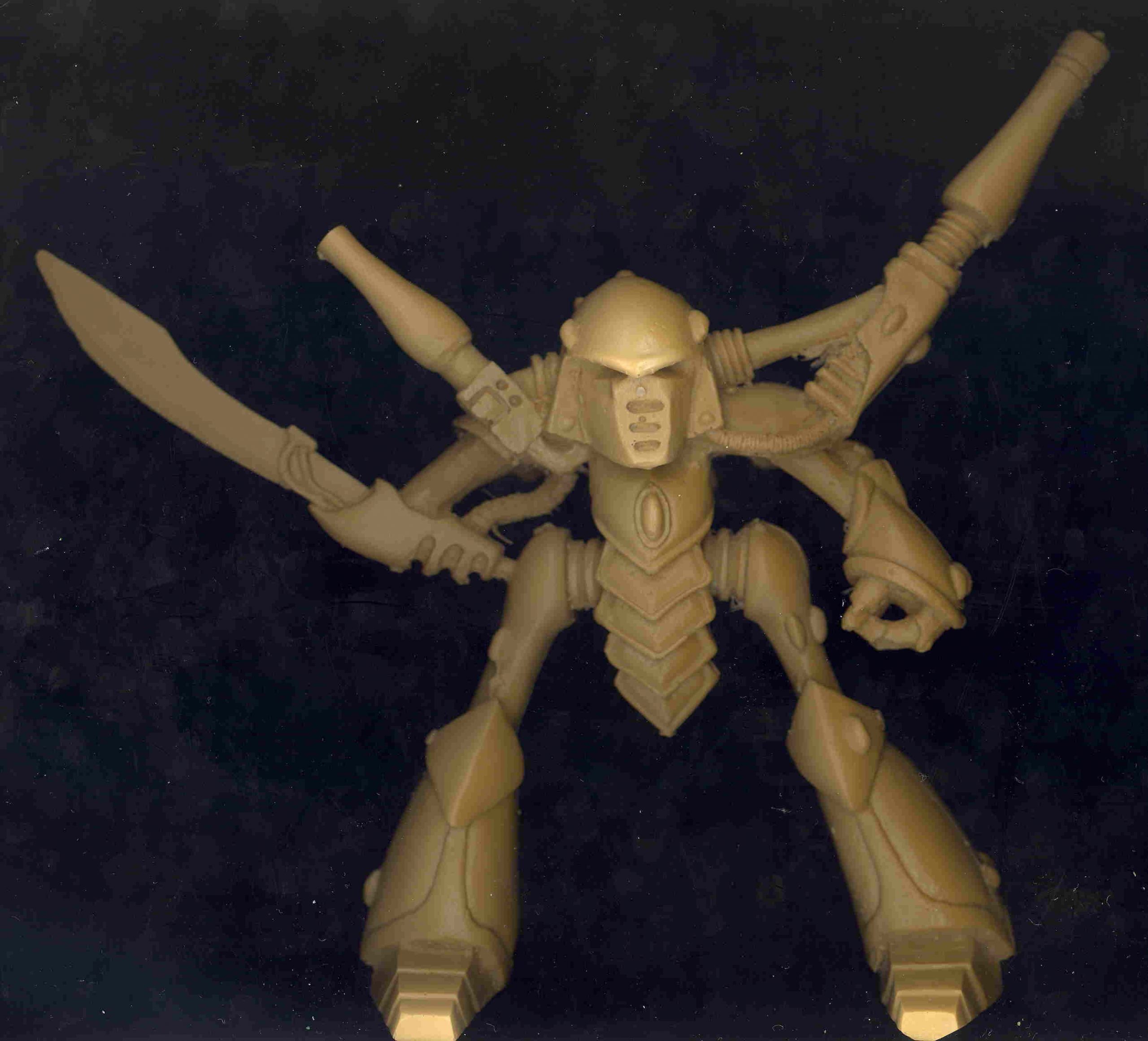
During the 90s we’d see four licenced producers of these large resin kits emerge (these would fall under the heading of garage kits in my opinion, being all small scale manufacturers based around one or two talented individuals rather than operations on the scale of a lot of modern miniature companies) – Mike Biasi Studios, Epicast, Forge World Models and Armorcast (note this is original Forge World, modern Forge World is completely unrelated). These were all located in California, and Forge World and Armorcast both started with revisions of Mike Biasi’s work. Everyone involved here knew each other and obtained a licence from GW.
Epicast produced several Human Knights based on the 1994 Titan Legions Epic scale releases – the Paladin, Crusader, and Errant – though never officially released them. Epicast also produced two Stompas, which were the Ork Knight equivalent introduced in the Epic Stompas! box.
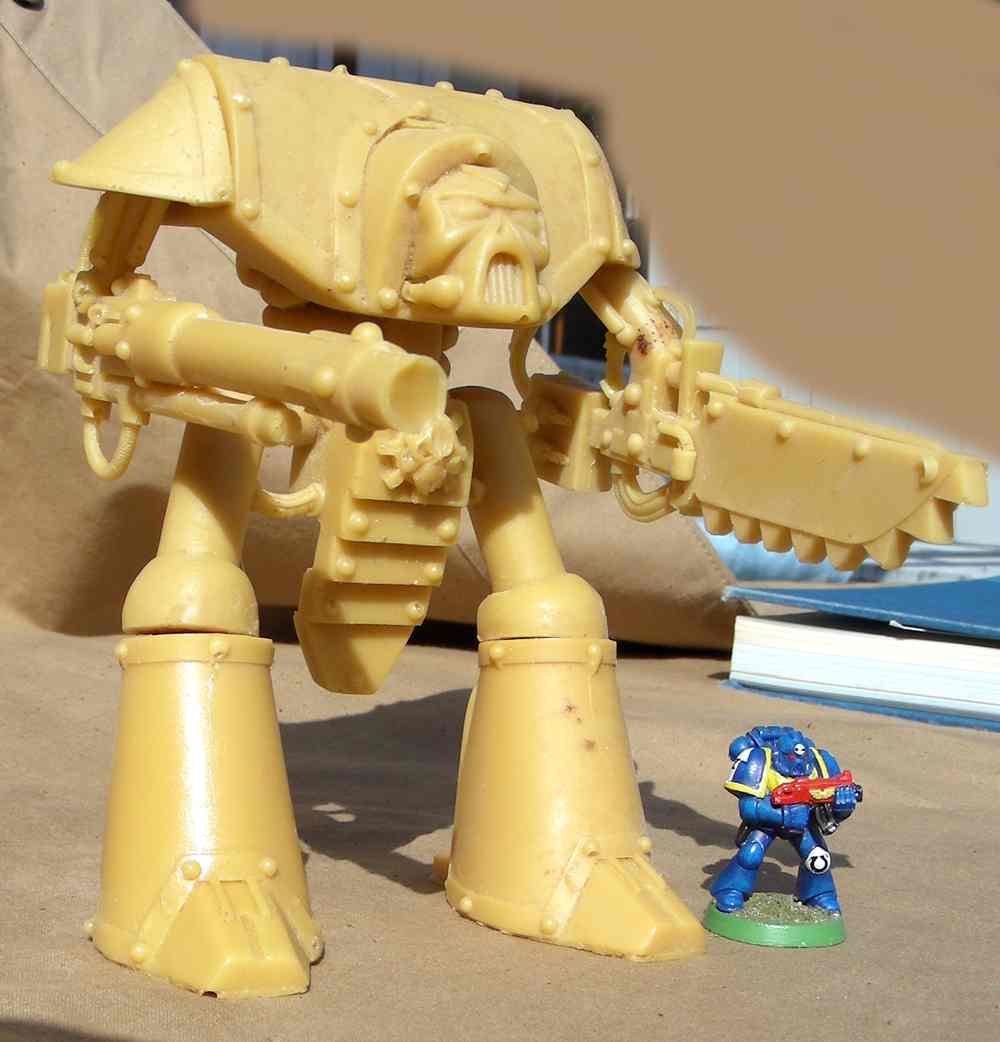
There was also a Bright Stallion Eldar Knight sculpted by David Hildebrand but never released.

Robnote: These guys, particularly Armorcast, produced a bunch of other scaled-up Epic minis as well, including a lot of the old Tyranid monsters. They were big, chunky models and these days are pretty tough to find.
So the 90s was very interesting in terms of Games Workshop resin kits, with a lot of super heavy units from Titans, to Knights, to super heavy tanks, being manufactured under licence in the secondary market.
All of these secondary manufacturers stopped producing Games Workshop kits in 1998 (with GW opening Forge World soon after), though Armorcast still manufacture resin kits now.
The Modern Era
Epic eventually went out of print – while Epic Armageddon sold well initially it was a victim of the end of Specialist Games in 2013 – and the resin garage kits of the 90s went out of production after GW ended their licence agreements around the release of 3rd edition. As a result, we went more than a decade without 40k-scale knight models available – at least, not unless you were able to track down out-of-production models and homebrew some rules for them.
Things changed a bit with the release of Apocalypse in 5th edition – a 2007 release that introduced large-scale games to 40k. Apocalypse (and its Reloaded expansion) introduced rules for a host of new super-heavy models to the game, including many models that had been built by Forge World such as the Thunderhawk Gunship and Warhound Scout Titan, as well as the Baneblade (then available as a Forge World resin kit) and the Ork Stompa.
2009 would give us our only Knight equivalent model, when in January GW released the Ork Stompa, which as a kit has some issues with fragility, but when it was released alongside a plastic version of the Baneblade. These would eventually prove both that there was a market for large centerpiece kits and that GW could engineer plastic models that size. The Baneblade spawned a number of additional sprues to create other Imperial Guard super heavy tanks, and the Forge World Baneblade and replaced variants were removed from sale.
Then in 2013 came the terror of 6th edition: The Eldar Wraithknight.
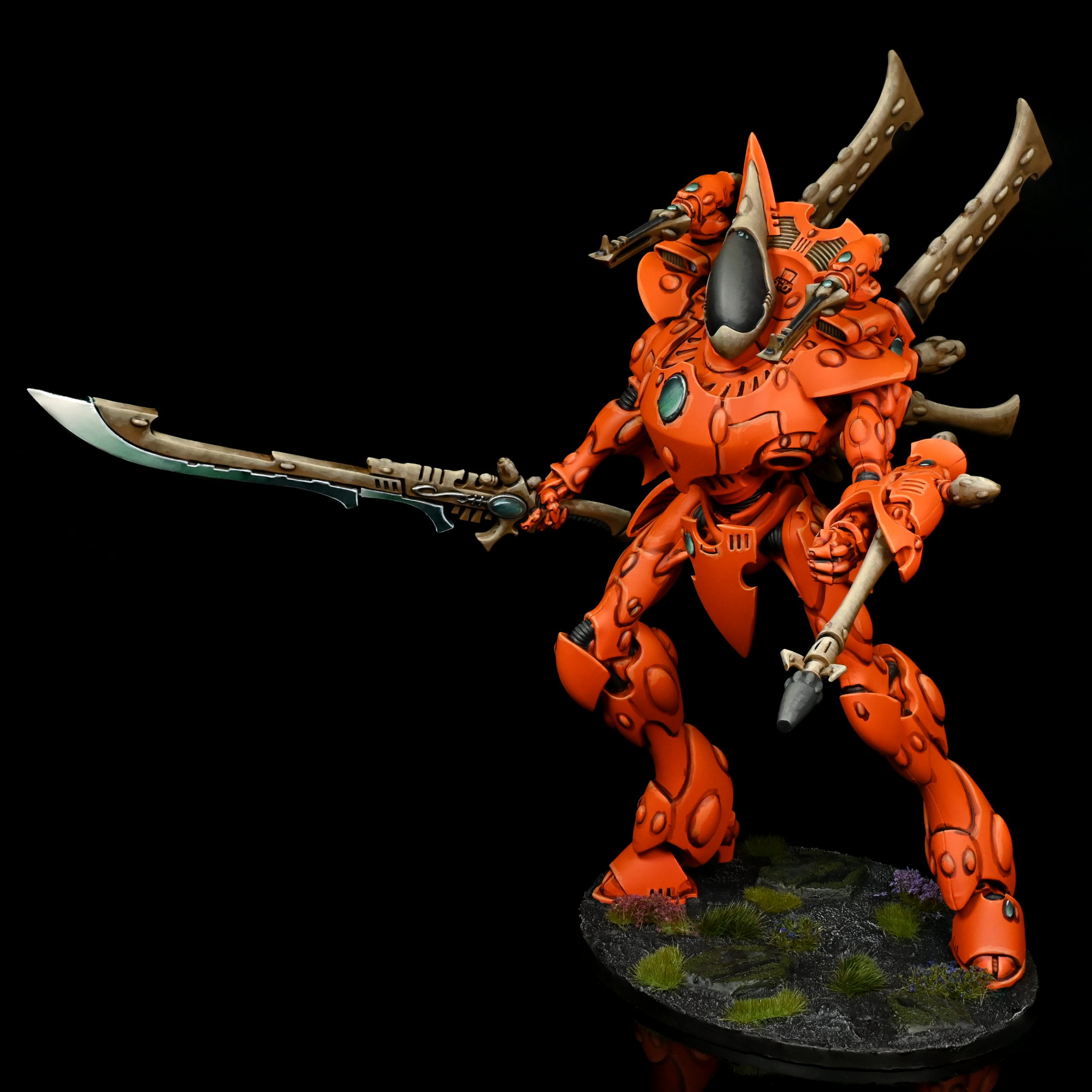
The design of the Wraithknight clearly drew from the Fire Gale models of 1990, and the various Ratholed and Wraithguard models and kits (bear in mind that the smaller wraith constructs went through their own evolutions, with Wraithlords simply improving in their design while Ghost Warriors evolved into Wraithguard which evolved into the multi-option kit they currently are).
In lore terms, the Eldar Knights were always partially managed by soulstones, but the 6th edition Eldar codex threw in some grimdark stuff about twins being pilots, one of whom was dead (and possibly pushed down a path of fate that would lead to their death by the Farseers, because what a dying race needs is there leaders deliberately getting some of them killed). It was some dumb fluff that didn’t reflect the original fluff and I’m hoping it get’s re-retconned at some point, or it’s revealed the Exodites don’t do that because it’s stupid and the Craftworlders are doing it because they’ve misunderstood something somewhere. Imagine how cursed being twins are on any Craftworld engaged in major combat operations like Biel Tan would be, with your local Farseer encouraging you to make toast in the bath and stand under ladders.
The Wraithknight, at the time being a Monstrous Creature and not a vehicle, could tank significantly more damage than a dreadnought or vehicle of equivalent points, and this led to some large problems with balance. These problems were exacerbated by people taking at least three of them, or running “Taudar” – a Tau force with Riptides and an allied Eldar force with Wraithknights, all exploiting the fact that their giant robots used the Monstrous Creature rules. This reflects the perennial issue of GW thinking they’ll make a centrepiece unit really cool and powerful and then players thinking “I’ll take only this really cool and powerful unit and the absolute minimum of compulsory choices, because my army is themed around the concept of enjoying winning games.” This led to a lot of Wraithknight hate, as you would expect.
Forge World would later release a variant of the Wraithknight, the Skathach Wraithknight, with two variants each with different weapon options. All additional knights are welcome, but I’d like to have seen something more radical than merely having more weapon options.

I think it’s a shame we haven’t seen more Eldar Knight types, and there’s a rich vein as yet untapped in game terms of Eldar Exodites and their various knights. I’d love to see GW do an Exodite codex at some point with a variety of Eldar Knights, various Exodite and Path of the Wanderer units, and some dinosaurs.
The Imperium Strikes Back
Not to be outdone by the knife-ears, in February 2014 we saw the launch of the Imperial Knights Codex, bringing Knight Paladins and Knight Errants to the game. The Knight kit was a huge seller immediately, and Knight armies introduced a number of issues to the game due to the vehicle rules that were active in 40k for most of its editions through 7th, during which armour values dictated which weapons could actually damage a vehicle – weapons with a strength lower than 8 tended to be useless for this purpose (and the useless weapons were all basic infantry weapons).
In the meta this meant a lot more anti-tank weapons were needed in armies, and there was a lot of competitive bickering about the meta. The codex itself came out only a few months before 7th edition was launched, changing the vehicle rules once again.
Rules aside, it’s worth talking about the model. Again sculpted by Jes Goodwin, the Knight was an evolution of the Adeptus Titanicus Knight Paladin 1 & 2 variants, and Jes talked at length in White Dwarf 4 (this was in the first month of White Dwarf’s shift to weekly issues focused on the release of the week, and the Knight issue is actually very good due to both the article discussing the evolution and design process of the Knight and the step by step painting and assembly guide for the knight) about it.
As readers are unlikely to have walked into a Games Workshop (the only place you could buy the weekly White Dwarf) that one week in 2014 I have quoted the relevant section below:
“Creating an Imperial Knight for Warhammer 40,000 is the realisation of a long held
dream,” Jes says, by way of introduction. “The model is descended from the Imperial
Knight Paladin I sculpted for Adeptus Titanicus more than 20 years ago, and since then I
have wanted to bring the same styling and ideas to Warhammer 40,000 – but we’ve never
truly had the opportunity or resource to create a fitting miniature. Even back then, and in
the tiny scale in which we made Epic models, the Paladin had a very distinctive design: a
beetle-back carapace, with head sunk deep between the shoulders, weaponised arms set
beneath large, curved shoulder pads. It’s a theme we’ve seen on the Reaver and Warlord
Titans too, a design that speaks to common origins and a unified design ethos.
“In some ways, returning to the Imperial Knight seems a little bit like an archaeological
exercise,” Jes quips. “We have enjoyed unearthing it. It is a miniature rooted in the ideas
and designs of the past, and many of the things you can see on the model are informed
not only by its diminutive predecessors, but also by the background that places it squarely
in the Warhammer 40,000 universe.
“The early history of the Imperial Knights mentioned how they were originally built with
the intention of helping with the work of colonisation,” says Jes. “That inherent
practicality is communicated in many of the aspects of their design. The reaper
chainsword, considered such a fearsome weapon on the battlefield, was clearly once
intended for clearing huge areas of vegetation for the early settlers. Each of the weapons
has heavy duty lifting hooks attached to it, and you can imagine practical colonists
hooking up digging or lifting apparatus just as easily as you can picture them drawing a
powerful battle cannon out of stores to fend off marauding Orks or Eldar. Many of the
practical considerations of the model are now hidden under the sloped armour plates and
heraldry of the Imperial Knight, but we were conscious to design a miniature which
connected with the stories behind the model. If you were to leave the armour plates off of
your model, you would have a war machine that resembled the functional construction
machines of the past.
“We also wanted to give a sense of narrative to the miniature that people would be able to
identify with,” Jes adds. “We imagined that the parts for a suit of knight armour are
forged by the sacristans sworn to the knightly houses. As you look at the large armour
plates, it’s easy to imagine menials pouring molten metal into massive sand casts, the raw
practicality of the task at odds with the ritual and dogma of creation instilled by the
Adeptus Mechanicus.”
The Imperial Knight model was hugely popular, and while the codex was invalidated to some extent only a few months later, it would be back for 7th edition a little over a year later, with a new upgrade sprue supporting three additional knight classes on the same chassis.
With the first Knight Codex, GW also published The Imperial Knight Companion, which has large fluff sections and even larger sections expounding on the heraldry of the Knight houses, and how they develop and display them. It’s now on Warhammer Vault, and if you have Warhammer+ is well worth a read. The GW studio come up with in universe explanations for a lot of things, and it’s always interesting to see them publish these.
However as the main studio brought out the Imperial Knight kit in the dank dungeons of Forge World, they were working on new classes of knights.
The Knights of the Forge World
In 2014 Forgeworld were showing off a number of pieces of concept art as well as their new Cerastus Knight Lancer.
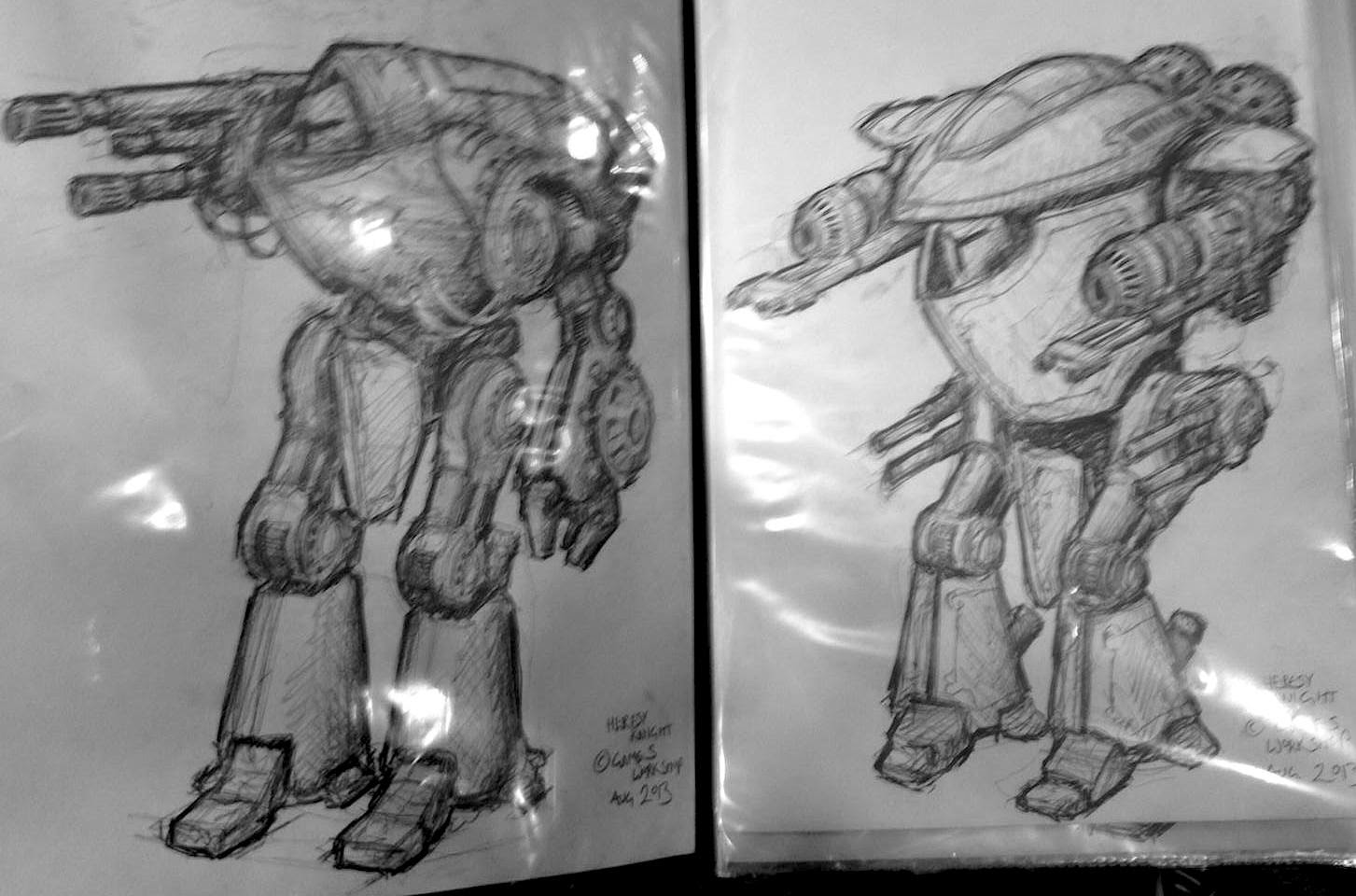
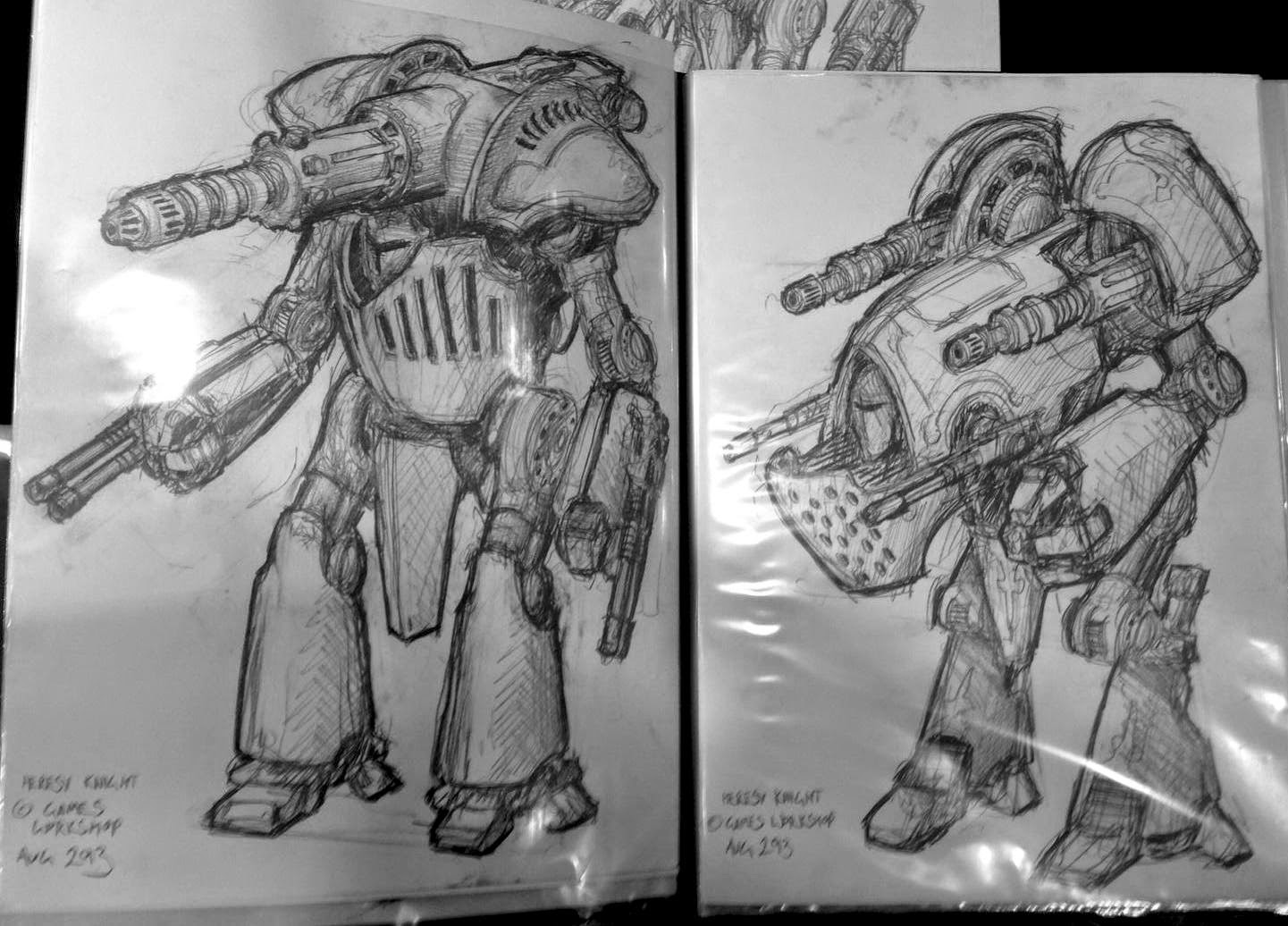
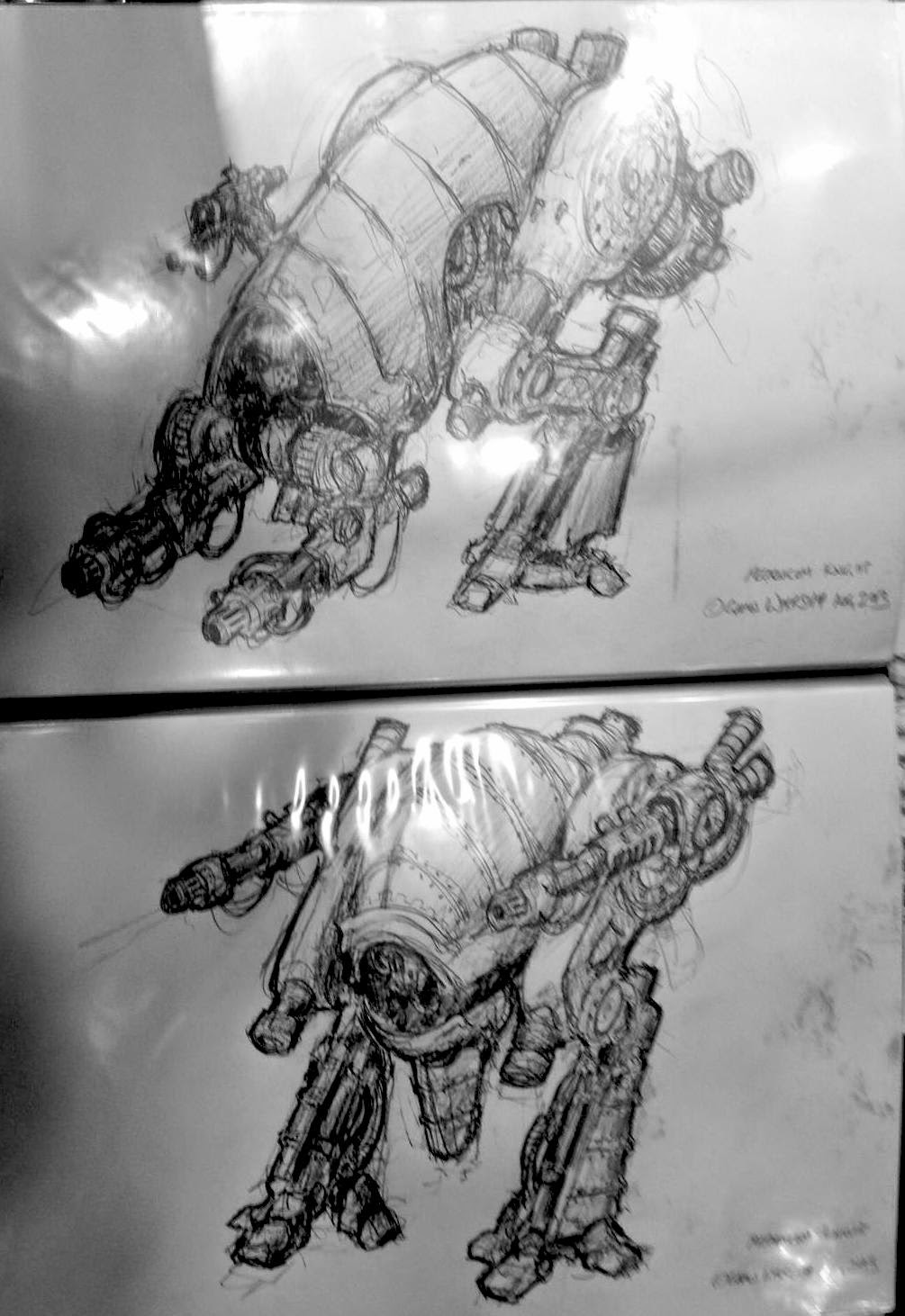

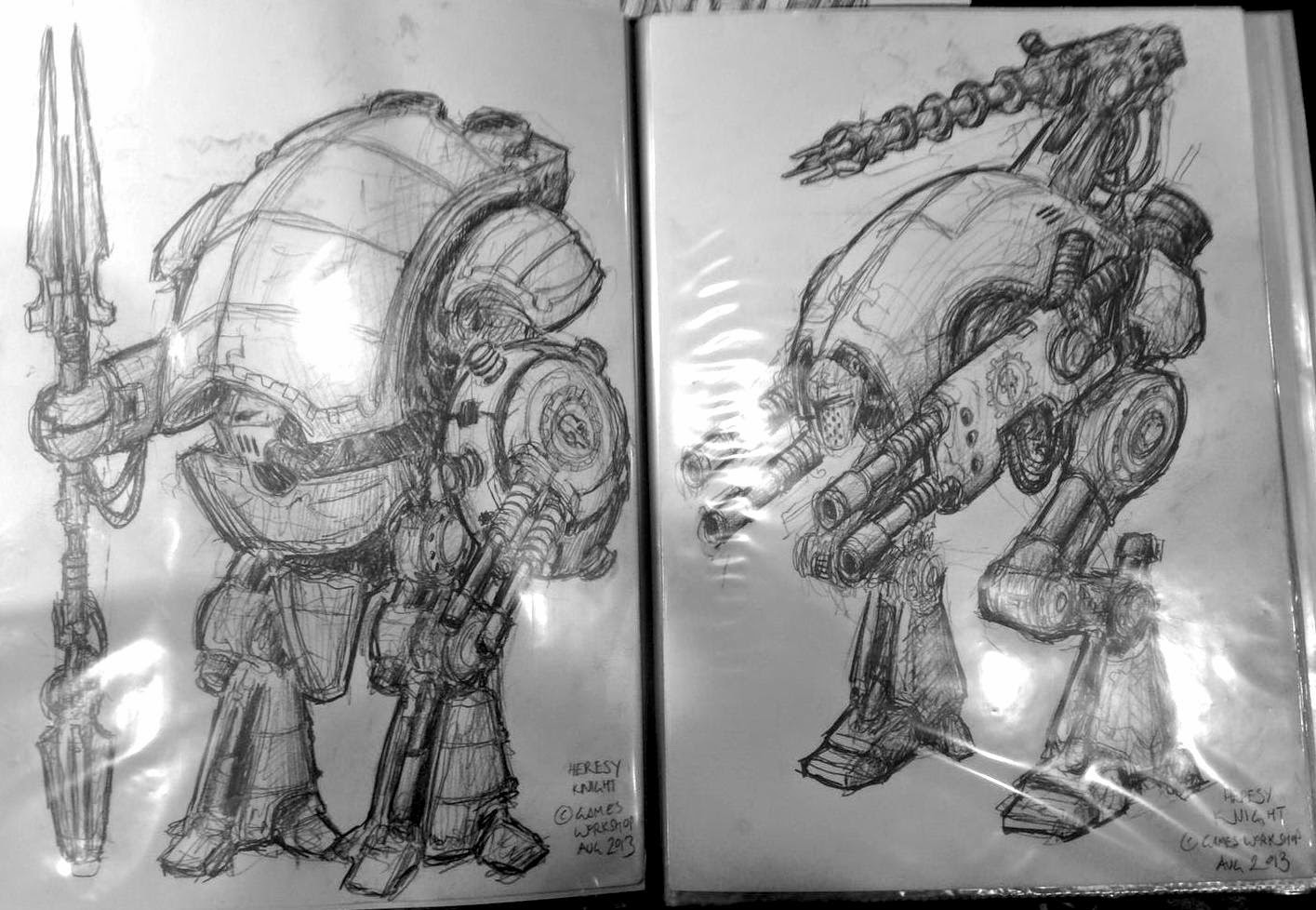
You can see the influences of the 1990 Warden Knights in the concept art, and you can see the design elements that are repeated in the Mechanicum knights. I’d have loved to see the Space Crusade Dreadnought-style knight turned into a mini, but given that sometimes the time between concept art and minis can be decades, I’m not giving up yet. You can see the chonk knight, the Acastus, in an early form here as well.
The Knight Lancer, which had rules in Horus Heresy Black Book 3, was previewed and released in 2014, followed shortly after by two other Cerastus class Knights, the Acheron and Castigator. It did put down a marker of Forge World releasing even larger knights, them not being in the codex, and then erratic rules updates to keep up with the changes in 40k. Knights, more than any other faction, have issues with this mainline/Forge World split in rules terms, as so many potential army choices and themes are tied up in Forge World minis that require a separate book and haven’t been designed alongside the Knight codex and its interactions. You can see the possible issues this has with balance, and I hope in the future some of the FW kits are converted into plastic and incorporated into the main codex.
That Gobbo</a></p>
" data-medium-file="https://d1w82usnq70pt2.cloudfront.net/wp-content/uploads/2020/04/IMG_20191227_195950-Edit-603x750.png" data-large-file="https://d1w82usnq70pt2.cloudfront.net/wp-content/uploads/2020/04/IMG_20191227_195950-Edit-823x1024.png" class="lazyload size-medium wp-image-19109" src='data:image/svg+xml,%3Csvg%20xmlns=%22http://www.w3.org/2000/svg%22%20viewBox=%220%200%20603%20750%22%3E%3C/svg%3E' data-src="https://d1w82usnq70pt2.cloudfront.net/wp-content/uploads/2020/04/IMG_20191227_195950-Edit-603x750.png" alt="Cerastus Knight-Castigator" width="603" height="750" data-srcset="https://d1w82usnq70pt2.cloudfront.net/wp-content/uploads/2020/04/IMG_20191227_195950-Edit-603x750.png 603w, https://d1w82usnq70pt2.cloudfront.net/wp-content/uploads/2020/04/IMG_20191227_195950-Edit-768x956.png 768w, https://d1w82usnq70pt2.cloudfront.net/wp-content/uploads/2020/04/IMG_20191227_195950-Edit-823x1024.png 823w, https://d1w82usnq70pt2.cloudfront.net/wp-content/uploads/2020/04/IMG_20191227_195950-Edit-1024x1274.png 1024w, https://d1w82usnq70pt2.cloudfront.net/wp-content/uploads/2020/04/IMG_20191227_195950-Edit-868x1080.png 868w, https://d1w82usnq70pt2.cloudfront.net/wp-content/uploads/2020/04/IMG_20191227_195950-Edit.png 1400w" data-sizes="(max-width: 603px) 100vw, 603px" />
By June 2015 we Games Workshop had released the 7th edition Knight codex, with 5 types of Knight, along with the new Cerastus Knight Lancer. Four of the Epic Knights – Paladin, Errant, Castellan and Crusader, had been combined into the standard knight kit, along with the new Gallant, a melee knight.
The Forgeworld Cerastus Knights was hitting gaming tables, and the future looked bright as the first of the Mechanicum Knights, the Mageara, came out.
But that was not the end. 2015 saw the Cerastus Knight Atropos and Questoris Knight Styrix released, and the end of 2016 the release of the Acastus Knight Porphyrion, adding a heavyweight class to knights. The Acastus class knights were reminiscent of the Wardens of 1990 and created a new class of Knight just below Warhound scout titans in terms of size. Initially these were significantly smaller than the model’s final size, but the development of Adeptus Titanicus apparently led to a change of size.
With 7th edition winding down into 2017, Knights were in a good place as an army. The GW codex had five datasheets and Forge World supplied another seven, giving a decent variety for both 30k and 40k. Forge World even created the first Chaos Knight at this point, a conversion kit for the plastic Knight Warden that gave Chaos players a way to get in on the fun.
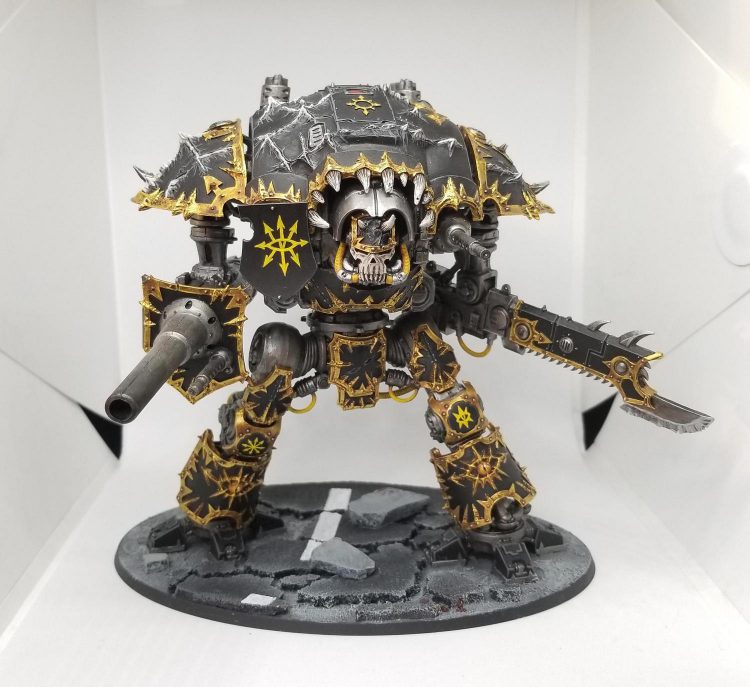
the Chaos Knight at this time was far from the full release we’d see later, and instead was supported by a single rules PDF. However the model itself had some fairly solid in-game rules, in part owing to just having a daemonic invulnerable save all the time compared the the rotating ion shields of its imperial cousins.
The Big Change
In 2017 Games Workshop released the 8th edition of Warhammer 40,000, and with it a major change to the vehicle rules. Gone were facings and armour values, as the rules reverted to something more akin to a stripped-down version of the Rogue Trader vehicle rules, with all vehicles having toughness and wounds, and heavier weapons going back to doing multiple wounds, or rolling dice to determine the number of wounds they did.
This radically changed how knights worked, and finally gave small arms the ability to chip away at them and made them less oppressive to play against. Doubtless other people will talk about the virtues of 8th edition indexhammer, but it was certainly a lot less complicated than trying to remember all the stratagems.
Knights would receive major support from the Forgebane boxed set in March 2018, giving us the Armiger Warglaive, and the game’s first babby knights. These smaller knights, a little bigger than dreadnoughts, operated as scouting and screening elements for their larger kin, and were piloted by the lower orders of knight house nobility and those in training.
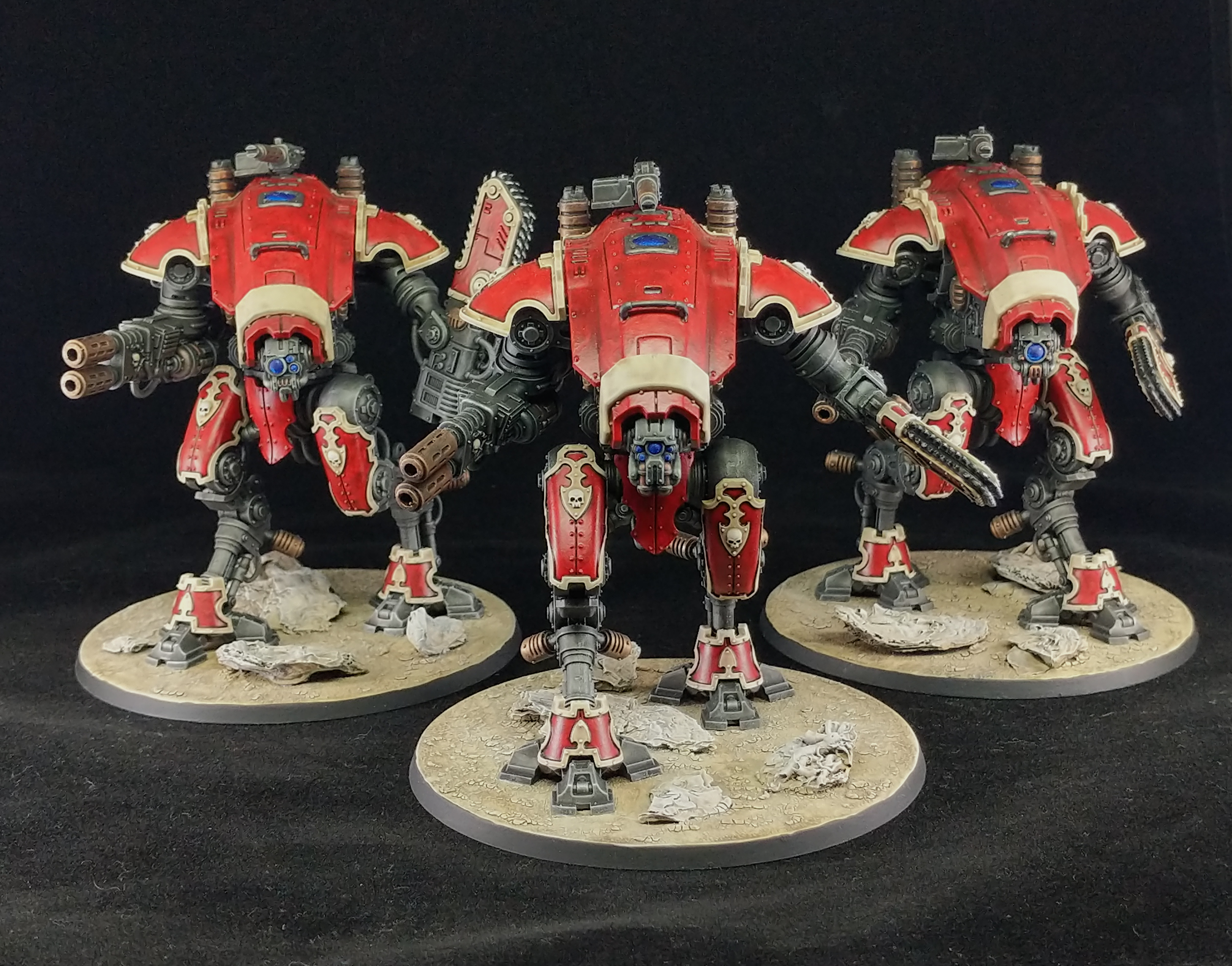
Honestly I loved the kit, and the introduction of Armigers (and their inevitable evolution into a profusion of units) made small game knight armies possible and not necessarily horrific to play against. For people without huge amounts of time to paint, a six model thousand point force is achievable, and this flexibility in constructing forces made building knight armies a lot more diverse.
The Imperial Knight codex came out in June 2018. This gave us the Armiger class Helverin and Warglaive and the Dominus Class Knights, the Castellan and the Valiant. The Knight Preceptor (another sprue in the standard knight box) came out in September 2018, giving the faction the special character Canis Rex as well. In a year the number of units available to Imperial Knights doubled, and there was proper variety in size with Armiger, Questoris and Dominus classes available. Knights became quite a varied force, and it created a lot more opportunities for themes in forces, from a heavy siege force centred around a Dominus class to a screening and scouting force of Armigers. It also gave you the option to test the force out with some Armigers at Combat Patrol level and then expand into full sized knights.
At least, the intent was for knights to become a varied force. In 8th edition at this point the competitive scene was in the midst of Soup Fever, where players could freely take the best bits of various forces that shared a keyword to create the most synergistic force they could. Command point batteries like the “Loyal 32,” “Rusty 17,” etc. (Robnote: minimum-size detachments used to generate extra CP – detachments used to give you CP instead of costing them) were used in combination with relics that recovered or generated command points to exploit the stratagem rules as much as possible, and a number of these soup armies were built around Imperial Knights, particularly a Dominus class. Soup led to a lot of hunting through codices to find the most points-efficient unit, and then taking that and none of the surrounding units for context and balance. This led to a lot of bad feeling in the competitive scene around Knights, with the Knight Castellan dominating the competitive scene for nearly a year until the unit was given a severe points hike. 9th edition would also push back hard against the soup concept with changes to army construction.
Forge World followed the Knight codex up the following year with the Armiger Moirax and a selection of weapons for them, including conversion beamers, lightning locks and grav pulsars. This was a Mechanicum Armiger, with a lovely curved carapace and a shield generator instead of a top weapon and is a great model.

The Acastus Knight Asterius also came out, adding another super heavy knight unit and again we saw a child-sized model that would require special measures to transport. It had the rounded armour of a Mechanicum unit, a design style I really like and would like to see more of.

The current range of Imperial Knights looks like this:
- Acastus class – Asterius and Porphyrion
- Cerastus class – Lancer, Castigator, Acheron and Atrapos
- Dominus class – Valiant and Castellan
- Questoris class – Crusader, Errant, Gallant, Paladin, Perceptor, Warden, Magaera and Styrix
- Armiger class – Helverin, Moirax and Warglaive
19 separate knight types across five classes, some with flexibility for different weapons. This puts knights in a good place as an army.
But 2019 saw another release. For some, the dark times had come.
The Dark Knight Rises
In mid-2018 Games Workshop released a small pdf with rules for using Chaos Knights – then called Renegade Knights – on the Warhammer-Community site to coincide with the release of the Imperial Knights Renegade boxed set. The boxed set was basically a way to sell a pair of knights, being packaged with a Paladin, a Gallant, and some terrain. The PDF gave Chaos access to a pair of Renegade knight options – the Renegade Knight and the Renegade Knight Dominus – plus access to Renegade Helverins and Armigers, a single relic and Warlord Trait, and two Stratagems. It wasn’t a lot, but it was a pretty big boost for a Chaos faction that struggled to do ranged damage.
Chaos players were forced to get by on the Renegade Knights pdf for just under a year, until eventually Games Workshop released a full codex in 2019 – Codex: Chaos Knights. Compared to the previous pamphlets and online rules, this finally made Chaos Knights into a full faction, though large portions of it were still based on hobbyists converting their own Chaos Knights, or using the now OOP Chaos Knight armour plates from Forge World. You’d always been able to have Chaos Knights in 30k but there were no model differences between loyalist, traitor or neutral knight houses.

GW launched Chaos Knights with the Knight Desecrator (which could also make the Knight Rampager, the Chaos equivalent of the Knight Gallant). This kit had no sprues in common with the Questoris knight kit, creating a new base model for Chaos Knights which gave the Chaos Knights a different look, particularly in the armour panels. The upcoming 2022 Chaos Knight release adds an additional sprue to this to create the Knight Abominant, a new psychic knight.
The 2022 release also adds a specific War Dog model, which can be built as either a Karnivore (2 melee weapons), Stalker (one ranged and one melee weapon) or Brigand (two ranged weapons). Again, this is a new kit specifically for chaos, rather than just advising players to glue spikes on an existing Imperial model.
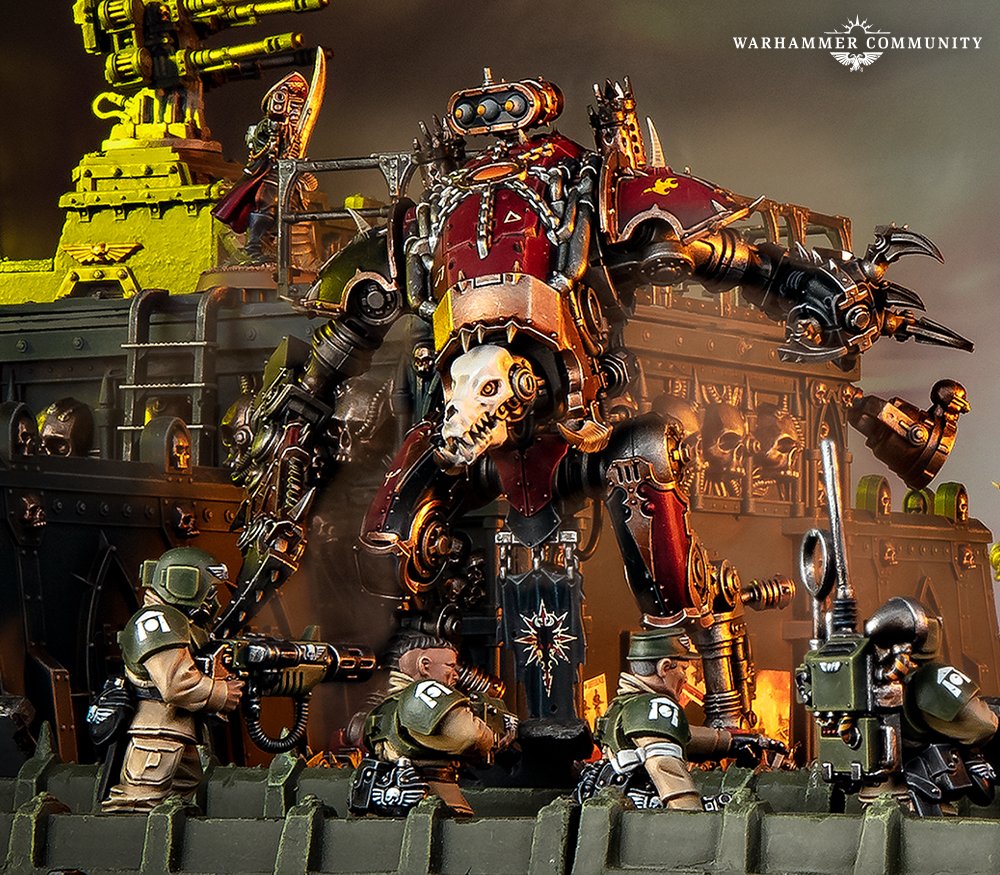
Chaos Knights, introduced properly from GW in 8th edition, are finally getting a greater separation from their Imperial counterparts, and this is a good thing… though it will inevitably lead to Imperial players complaining about Chaos players having stuff they don’t (though I don’t think any Chaos players have been complaining they don’t get Knight Preceptors). Of course, both have the full FW roster to pick from as well, though Chaos players still have to glue spikes on theirs.
Full Circle – Adeptus Titanicus 2019
In 2019 Adeptus Titanicus returned to us, bringing back Epic scale and giving us a completely rewritten game by talented designer James Hewitt (no, not that James Hewitt). Originally conceived as a Titan-vs-Titan game, Adeptus Titanicus 1989 was expanded into the original Epic, giving us Knights and a profusion of other vehicles.
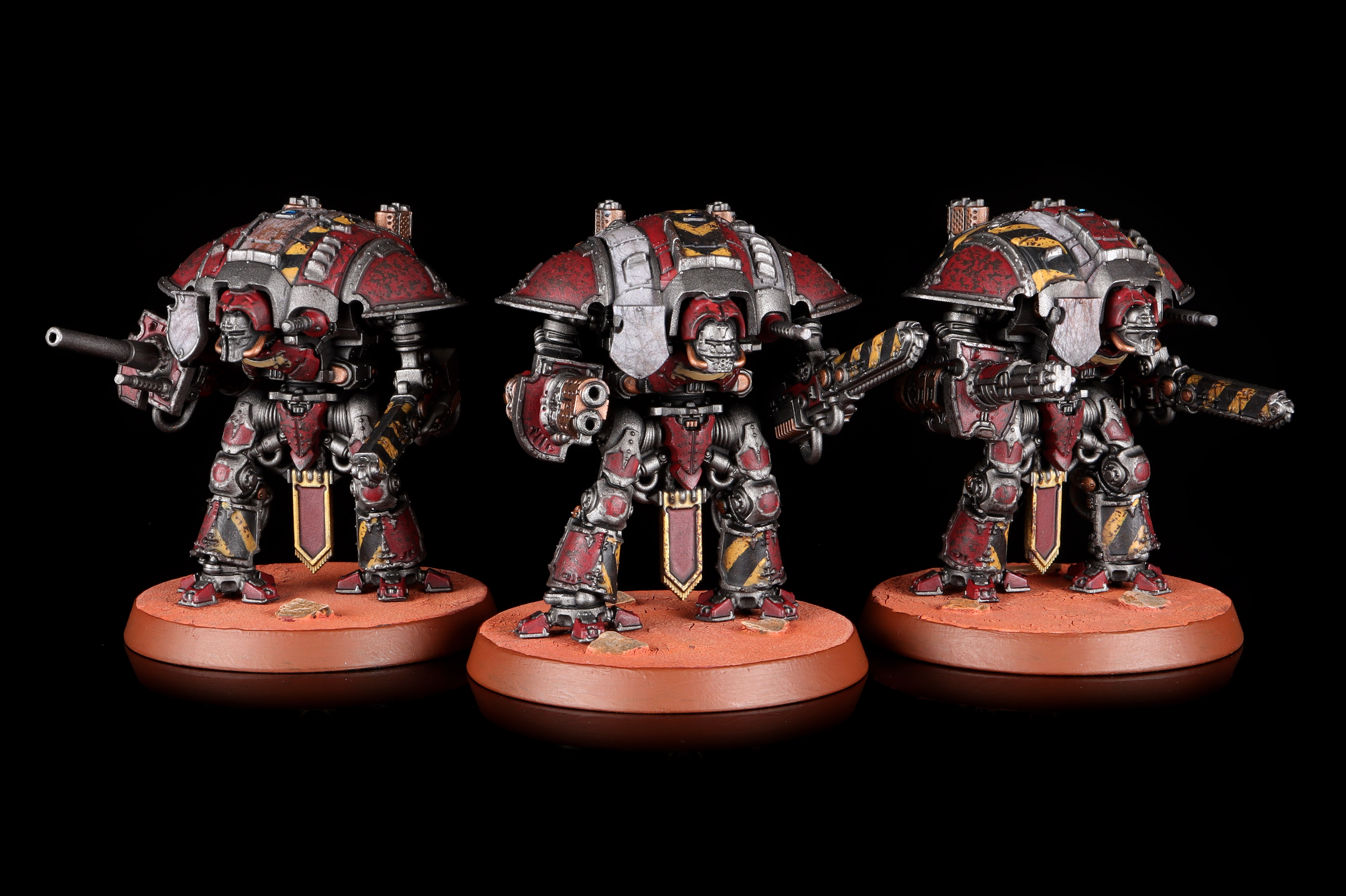
Adeptus Titanicus 2019 did the same. GW paused releasing the game (originally scheduled to come out in 2018) and did a number of the models in plastic, and the initial release included Questoris Knights. Soon a sprue with additional weapons was added to these, and then plastic Cerastus Lancers, plastic Acastus Porphyrions and plastic Cerastus Acheron and Castigators.
And then FW produced every other Knight model except the Preceptor and Dominus class in resin.
The Adeptus Titanicus Knights are very good, well engineered and sculpted and paint up nicely and quickly. Once more you can fight Epic battles in the grim darkness of the far future with purely Knights, using the Knight Household rules.

Wrapping Things Up
So in a little over thirty years, we’ve watched Knights be introduced in Epic scale, turn up in 40k through third party producers, disappear from both, then triumphantly return to 40k and become a part of the fabric of the game with a well supported model range and Imperial and Chaos versions, and then come full circle and then return to Epic scale with a much more detailed and beautifully sculpted range that covers almost the entire 40k model range.
We’ve seen Jes Goodwin evolve the Knight Paladin and Fire Gale into their modern incarnations, the Questoris Knight and Wraithknight, as centre piece kits for 40k. What does the future hold? I’m hoping Jes dusts off his sculpting stylus and gives us more Eldar Knights, as an Eldar Exodite army would be great, or GW give us greater differentiation between Imperial and Chaos Knights or even convert the Cerastus class to plastic. I hope Adeptus Titanicus spawns Knight sized demon engines that eventually make their way to 40k.
From Forge World I’m hoping we see some support for Chaos Knights, and I’m hoping we see them dip their toes into doing transfers for some of the Knight Houses in the Adeptus Titanicus books. If they did a Chaosified Moirax that would also be superb, and more weapon, head or armour options for any of the Knight classes would be welcome. A few Chaos resin armour pieces for the Dominus would go a long way to making the Tyrant class distinctive from it’s Imperial counterpart for example.
There’s also definitely a gap where the Mechanicum Knights sit. There are Knight Houses on Adeptus Mechanicus Forge Worlds, and I think there’s space to explore this with integrating things like Moirax into Adeptus Mechanicus forces. However I’d say the same thing about Thallax and various robots if Forgeworld kits are going plastic. Knight Houses like The Pact of Morbidia, who directly serve the New Mechanicum, give us a glimpse of non-independent Knight Houses. Certainly if Forge Worlds are producing all these knight armours, including specific cool looking Mechanicum Knights, there’s space in the army books for Knights integrated into Mechanicus forces.
Centre piece kits are a key feature of GW ranges now, and Knights are the poster child for this in 40k. Technology has significantly improved and every range is getting large models, so I would expect more Knight releases in 10th edition. The Cerastus Knight I think would be possible to do well now. There’s certainly space for more knights, Chaos, Imperial or Eldar, on people’s shelves and in their cabinets.
Have any questions or feedback? Drop us a note in the comments below or email us at contact@goonhammer.com.

